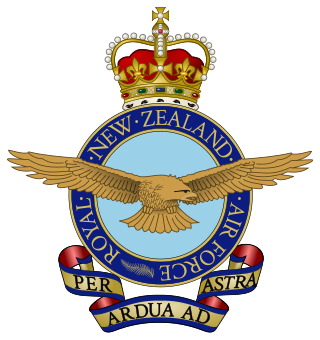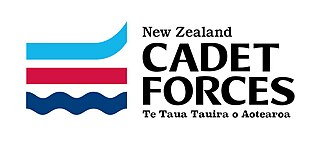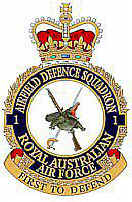
The Royal New Zealand Air Force (RNZAF) is the aerial service branch of the New Zealand Defence Force. It was formed from New Zealand elements of the British Royal Air Force, becoming an independent force in 1923, although many RNZAF aircrew continued to serve in the Royal Air Force until the end of the 1940s.
Airfield Defence Guards (ADG) are a mustering of the Royal Australian Air Force (RAAF) that are dedicated to the security and ground defence of airbases and other military aviation assets. Other duties include training other RAAF personnel, in skills such as the handling of small arms and infantry tactics. They do not, however, operate anti-aircraft artillery or missiles.
No. 42 Squadron is an active transport squadron of the Royal New Zealand Air Force (RNZAF). It was formed at Rongotai Airport (Wellington) in December 1943 to provide a communications service around New Zealand, initially using impressed civilian types. It was briefly officially disbanded in 1946, but its aircraft continued with general purpose operations at RNZAF Station Ohakea. When reformed, the squadron was equipped with various numbers of North American Harvard, Auster, Grumman Avenger, Airspeed Oxford, de Havilland Devon, North American P-51 Mustang and Douglas Dakota aircraft.

Chemical, biological, radiological and nuclear defence are protective measures taken in situations in which chemical, biological, radiological or nuclear warfare hazards may be present. CBRN defence consists of CBRN passive protection, contamination avoidance, and weapons of mass destruction mitigation.

The New Zealand Air Training Corps is one of the three corps in the New Zealand Cadet Forces, alongside the Sea Cadet Corps and New Zealand Cadet Corps. It is funded in partnership between the RNZAF and local communities, with its members being civilians. Members are under no obligation to enlist in the New Zealand Defence Force. Should a cadet enlist their service in the ATC cadet does not translate into higher pay, rank, or seniority.

The New Zealand Cadet Forces is a voluntary military-style training organisation for New Zealand youth between the ages of 13 and 21. Run in partnership with the New Zealand Defence Force (NZDF) and local community organisations. Through its three branches, the New Zealand Cadet Forces provide young adults with a four-year training curriculum, while a number of local, area, and national camps and courses provide further experience and qualifications. It is jointly funded by the Ministry of Defence, the Royal New Zealand Returned Services' Association, local communities, and the Associated charities belonging to each branch. Overall it is directed by Air Marshal Kevin Short, Chief of Defence Force. Cadets are not under any obligation to join the New Zealand Defence Force, however many choose to do so upon turning 18 years old.

The Canadian Forces Military Police provide police, security and operational support services to the Canadian Armed Forces (CAF) and the Department of National Defence (DND) worldwide.

No. 5 Squadron RNZAF is a squadron of the Royal New Zealand Air Force formed during November 1941 in Fiji. It remains on active duty and logged 2,300 hours flight time in 2007.

The United States Air Force Security Forces (SF) are the ground combat force and military police service of the U.S. Air Force and U.S. Space Force. USAF Security Forces (SF) were formerly known as Military Police (MP), Air Police (AP), and Security Police (SP) at various points in its history. Due to its significant ground combat mission, Security Forces are often regarded as Air Force infantry within the Air Force and were formed on the premise of being the Air Force's "Marine Corps", in that they would provide security for the Air Force similar to how the Marines provide security for the Navy.

RNZAF Base Woodbourne is a base of the Royal New Zealand Air Force, located 8 km west of Blenheim.

RNZAF Base Auckland is a Royal New Zealand Air Force base located near the upper reaches of the Waitematā Harbour in Auckland, New Zealand. The base formerly comprised two separate airfields, Whenuapai and RNZAF Station Hobsonville. Hobsonville was established as a seaplane station in 1928 and was the RNZAF's primary flying boat base in New Zealand until 1967. Construction of Whenuapai as a base for Vickers Wellington bomber aircraft began in 1937, the hangars being built in 1939. Whenuapai was also Auckland's civil international airport from 1945 to 1965. After World War II Auckland became a centre for RNZAF transport and maritime squadrons. RNZAF Station Hobsonville was administratively joined with Whenuapai in 1965 to become RNZAF Base Auckland. Hobsonville subsequently became a grass airfield for No. 3 Squadron RNZAF, which later moved to Ohakea. A New Zealand Army unit comprising various personnel from different regiments as well as the New Zealand Special Air Service were relocated to Papakura Military Camp in 2003.

RNZAF Base Ohakea is an operational base of the Royal New Zealand Air Force. Opened in 1939, it is located near Bulls, 25 km north-west of Palmerston North in the Manawatu. It is also a diversion landing point for civilian aircraft. The base's motto is Defensio per vires.

No. 488 Squadron was the name given to two distinct Royal New Zealand Air Force squadrons during the Second World War. Both were formed under Article XV of the Empire Air Training Scheme and served under the operational command of the Royal Air Force.

RAAF Base Tindal is a Royal Australian Air Force (RAAF) military air base and civil aviation airfield located 8 nautical miles east southeast of the town of Katherine, Northern Territory in Australia. The base is currently home to No. 75 Squadron and a number of non-flying units, and also hosts the civilian Katherine Tindal Airport. First constructed in 1942, it was refurbished in the late 1960s as a bare base capable of being utilised when required. It was opened as a permanently manned RAAF base in 1989.

No. 4 Squadron is a Royal Australian Air Force squadron composed of the air force special forces Combat Controllers, aircrew who operate the Pilatus PC-21 aircraft and instructors for the Australian Defence Force Joint Terminal Attack Controller (JTAC) course.
No. 2 Security Forces Squadron is an Australian military unit whose primary role is to protect and defend airfields, buildings, equipment, and personnel.
No. 3 Security Forces Squadron (3SECFORSQN) is an RAAF Security Forces unit, whose mission is to provide security in support of air and space power assets and infrastructure.

No. 1 Security Forces Squadron (1SECFOR) is a Royal Australian Air Force (RAAF) military unit whose primary role is to protect and secure airfields, buildings, equipment, and personnel.

Air force ground forces and special forces are ground forces, and may include special operations units that are part of a nation's air force. Airmen assigned to such units may be trained, armed and equipped for ground combat and special operations.

The 1st Regiment is a light infantry battalion of the Armed Forces of Malta. The Regimental Headquarters is at Lyster Barracks in Ħal Far. Lyster Barracks was a former Royal Navy and Royal Air Force barracks and originally named after Vice Admiral Sir Arthur Lumley St George Lyster. Admiral Lyster commanded the Fleet Air Arm force that protected the Operation Pedestal convoy force to Malta during World War 2. The current barracks site includes some of the original British military architecture and four of the accommodation blocks are named after famous Royal Navy aircraft carriers, some of whom were frequent visitors to Malta; i.e. Glorious, Courageous, Eagle and Hermes
















